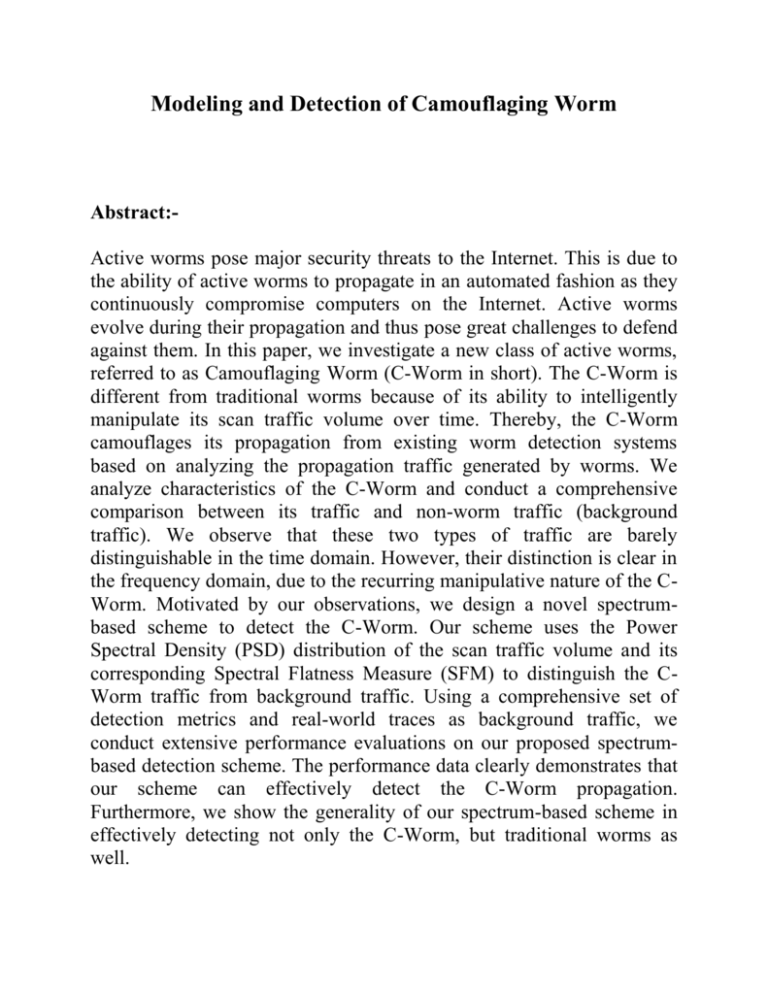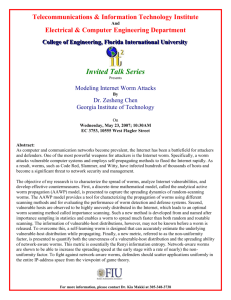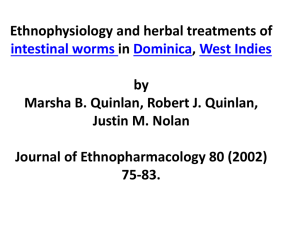Abstract - ChennaiSunday
advertisement

Modeling and Detection of Camouflaging Worm Abstract:Active worms pose major security threats to the Internet. This is due to the ability of active worms to propagate in an automated fashion as they continuously compromise computers on the Internet. Active worms evolve during their propagation and thus pose great challenges to defend against them. In this paper, we investigate a new class of active worms, referred to as Camouflaging Worm (C-Worm in short). The C-Worm is different from traditional worms because of its ability to intelligently manipulate its scan traffic volume over time. Thereby, the C-Worm camouflages its propagation from existing worm detection systems based on analyzing the propagation traffic generated by worms. We analyze characteristics of the C-Worm and conduct a comprehensive comparison between its traffic and non-worm traffic (background traffic). We observe that these two types of traffic are barely distinguishable in the time domain. However, their distinction is clear in the frequency domain, due to the recurring manipulative nature of the CWorm. Motivated by our observations, we design a novel spectrumbased scheme to detect the C-Worm. Our scheme uses the Power Spectral Density (PSD) distribution of the scan traffic volume and its corresponding Spectral Flatness Measure (SFM) to distinguish the CWorm traffic from background traffic. Using a comprehensive set of detection metrics and real-world traces as background traffic, we conduct extensive performance evaluations on our proposed spectrumbased detection scheme. The performance data clearly demonstrates that our scheme can effectively detect the C-Worm propagation. Furthermore, we show the generality of our spectrum-based scheme in effectively detecting not only the C-Worm, but traditional worms as well. Existing System Existing worm detection schemes will not be able to detect such scan traffic patterns, it is very important to understand such smart-worms and develop new countermeasures to defend against them. Existing detection schemes are based on a tacit assumption that each worm-infected computer keeps scanning the Internet and propagates itself at the highest possible speed. Furthermore, it has been shown that the worm scan traffic volume and the number of worm-infected computers exhibit exponentially increasing patterns. Nevertheless, the attackers are crafting attack strategies that intend to defeat existing worm detection systems. In particular, ‘stealth’ is one attack strategy used by a recently-discovered active worm called “Attack” worm and the “self-stopping” worm circumvent detection by hibernating (i.e., stop propagating) with a pre-determined period. Worm might also use the evasive scan and traffic morphing technique to hide the detection Proposed System Proposed Worm detection schemes that are based on the global scan traffic monitor by detecting traffic anomalous behavior, there are other worm detection and defense schemes such as sequential hypothesis testing for detecting worm-infected computers, payload-based worm signature detection. . In presented both theoretical modeling and experimental results on a collaborative worm signature generation system that employs distributed fingerprint filtering and aggregation and multiple edge networks... In presented a state-space feedback control model that detects and control the spread of these viruses or worms by measuring the velocity of the number of new connections an infected computer makes. Despite the different approaches described above, we believe that detecting widely scanning anomaly behavior continues to be a useful weapon against worms, and that in practice multifaceted defense has advantages Modules 1. C-Worm detection Module Camouflaging Worm (C Worm). The C-Worm has a self-propagating behavior similar to traditional worms, i.e., it intends to rapidly infect as many vulnerable computers as possible. However, the CWorm is quite different from traditional worms in which it camouflages any noticeable trends in the number of infected computers over time. The camouflage is achieved by manipulating the scan traffic volume of worm-infected computers. Such a manipulation of the scan traffic volume prevents exhibition of any exponentially increasing trends or even crossing of thresholds that are tracked by existing detection schemes 2. Worms are malicious Detection Module OR Anomaly Detection Worms are malicious programs that execute on these computers, analyzing the behavior of worm executables plays an important role in host based detection systems. Many detection schemes fall under this category. In contrast, network-based detection systems detect worms primarily by monitoring, collecting, and analyzing the scan traffic (messages to identify vulnerable computers) generated by worm attacks. Many detection schemes fall under this category. Ideally, security vulnerabilities must be prevented to begin with, a problem which must addressed by the programming language community. However, while vulnerabilities exist and pose threats of large-scale damage, it is critical to also focus on network-based detection, as this paper does, to detect wide spreading worms. 3. Pure Random Scan (PRS) Module C-Worm can be extended to defeat other newly developed detection schemes, such as destination distribution-based detection. In the following, Recall that the attack target distribution based schemes analyze the distribution of attack targets (the scanned destination IP addresses) as basic detection data to capture the fundamental features of worm propagation, i.e., they continuously scan different targets 4. Worm propagation Module Worm scan traffic volume in the open-loop control system will expose a much higher probability to show an increasing trend with the progress of worm propagation. As more and more computers get infected, they, in turn, take part in scanning other computers. Hence, we consider the Cworm as a worst case attacking scenario that uses a closed loop control for regulating the propagation speed based on the feedback propagation status. System Requirements: Hardware Requirements: PROCESSOR : PENTIUM IV 2.6 GHz RAM : 512 MB DD RAM MONITOR : 15” COLOR HARD DISK : 20 GB FLOPPY DRIVE : 1.44 MB CDDRIVE : LG 52X KEYBOARD MOUSE : STANDARD 102 KEYS : 3 BUTTONS Software Requirements: Front End : Java, JFC (Swing) Tools Used : Eclipse 3.3 Operating System: Windows XP/7







